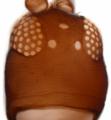Aeolothrips nasturtii
Recognition data
Distinguishing features
Female with banded wings; median pale band shorter than distal dark band. Body and legs brown, antennal segment III yellow with only extreme apex dark, IV slightly paler at base. Head and pronotum with no long setae. Fore tarsus apically with stout recurved ventral hamus. Antennae 9-segmented, segment III long and slender with linear sensorium about 0.25 as long as segment, IV with sensorium less than 0.5 as long as segment and curved distally; segment VI slightly constricted at base and thus V–IX not forming a single unit, with V clearly shorter than VI–IX. Median marginal setae on sternites arising at or close to margin but lateral pairs arise on disc; sternite VII supernumerary paired setae arising medially on sternite.
Related and similar species
A. nasturtii is possibly a member of the A. fasciatus group, but with antennal segment VI clearly constricted at the base, and segment V shorter than VI–IX. Because the male remains unknown, the identity of A. nasturtii remains problematical. Just over 90 species are placed currently in the genus Aeolothrips, of which more than 50 are from the Palaearctic Region (mainly Europe), and 28 from the Nearctic (mainly western USA). Only two species are recorded from the Neotropics; the one from Chile is probably the same as A. fasciatus, and one from Panama is probably not a member of this genus (Mound & Marullo, 1996).
Taxonomic data
Current valid name
Aeolothrips nasturtii Jones
Original name and synonyms
- Aeolothrips nasturtii Jones, 1912: 2
- Aeolothrips tuolumnei Moulton, 1927: 187
Family placement
Aeolothripidae
Biological data
Life history
Presumably flower-living as a facultative predator with a mixed diet of pollen and the larvae of other thrips.
Host plants
Swept from a wide range of flowers and grasses, with no information on specificity.
Tospoviruses vectored
None
Crop damage
None
Distribution data
Area of origin
Possibly western USA.
Distribution
Although described from California, this species is considered by Bailey (1951) to be widespread across the USA north of Georgia and California, and into Canada.





